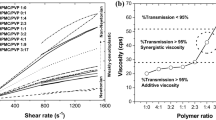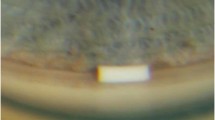Abstract
We are developing tablet dosage forms for implantation directly into the subconjunctival space of the eye. The matrix metalloproteinase inhibitor, ilomastat, has previously been shown to be efficacious at suppressing scarring following glaucoma filtration surgery (GFS). We report on the physical characterisation of ilomastat which is being developed for ocular implantation. Since ilomastat is being considered for implantation it is necessary to examine its polymorphs and their influence on aspects of the in vitro drug release profile. X-ray powder diffraction identified two polymorphs of ilomastat from different commercial batches of the compound. Tablets were prepared from the two different polymorphs. Isothermal perfusion calorimetry was used to show that amorphous content is not increased during tablet formulation. The melting points of the two polymorphs are 188 and 208°C as determined by differential scanning calorimetry. Utilising single crystal X-ray diffraction, the structural conformations and packing arrangements of the different polymorphs were determined. The orthorhombic crystal crystallised as a monohydrate while the second monoclinic crystal form is non-solvated. Ilomastat tablets prepared from the two different solid forms exhibited similar drug release profiles in vitro under conditions mimicking the aqueous composition, volume and flow of the subconjunctival space after GFS. This suggests that a reproducible dose at each time point during release after implantation should be achievable in vivo with ilomastat tablets prepared from the two polymorphs identified.











Similar content being viewed by others
REFERENCES
Pudipeddi M, Serajuddin ATM. Trends in solubility of polymorphs. J Pharm Sci. 2005;94(5):929–39.
Datta S, Grant DJW. Crystal structures of drugs: advances in determination, prediction and engineering. Nat Rev Drug Discov. 2004;3(1):42–57.
Giron D, Goldbronn C, Mutz M, Pfeffer S, Piechon P, Schwab P. Solid state characterizations of pharmaceutical hydrates. J Therm Anal Calorim. 2002;68(2):453–65.
Weinreb RN, Khaw PT. Primary open-angle glaucoma. Lancet. 2004;363(9422):1711–20. Epub 2004/05/26.
Reynolds AC, Skuta GL, Monlux R, Johnson J. Management of blebitis by members of the American Glaucoma Society: a survey. J Glaucoma. 2001;10(4):340–7.
Parrish R, Minckler D. “Late endophthalmitis”—filtering surgery time bomb? Ophthalmology. 1996;103(8):1167–8.
Georgoulas S, Dahlmann-Noor A, Brocchini S, Khaw PT. Modulation of wound healing during and after glaucoma surgery. Glaucoma: an open window in to neurodegeneration and neuroprotection. Prog Brain Res. 2008;173:237–54.
Wong TTL, Mead AL, Khaw PT. Matrix metalloproteinase inhibition modulates postoperative scarring after experimental glaucoma filtration surgery. Investig Ophthalmol Vis Sci. 2003;44(3):1097–103.
Wong TT, Mead AL, Khaw PT. Prolonged antiscarring effects of ilomastat and MMC after experimental glaucoma filtration surgery. Investig Ophthalmol Vis Sci. 2005;46(6):2018–22. Epub 2005/05/26.
Georgoulas S, Ru Q, Brocchini S, Khaw P. A novel single application prolonged release MMP inhibitor is superior to mitomycin in preventing scarring after experimental glaucoma surgery. Investig Ophthalmol Vis Sci. 2008;49:A4538.
Sheridan CM, Occleston NL, Hiscott P, Kon CH, Khaw PT, Grierson I. Matrix metalloproteinases: a role in the contraction of vitreo-retinal scar tissue. Am J Pathol. 2001;159(4):1555–66. Epub 2001/10/05.
Townley WA, Cambrey AD, Khaw PT, Grobbelaar AO. The role of an MMP inhibitor in the regulation of mechanical tension by Dupuytren’s disease fibroblasts. J Hand Surg Eur Vol. 2009;34(6):783–7. Epub 2009/09/30.
Brochhausen C, Schmitt VH, Rajab TK, Planck CN, Kramer B, Wallwiener M, et al. Intraperitoneal adhesions—an ongoing challenge between biomedical engineering and the life sciences. J Biomed Mater Res A. 2011;98(1):143–56. Epub 2011/05/07.
McLaren JW. Measurement of aqueous humor flow. Exp Eye Res. 2009;88(4):641–7.
Altomare A, Cascarano G, Giacovazzo C, Guagliardi A. Completion and refinement of crystal-structures with Sir92. J Appl Crystallogr. 1993;26:343–50.
Sheldrick GM, Schneider TR. SHELXL: high-resolution refinement. Macromol Crystallogr Part B. 1997;277:319–43.
Kawasaki S, Mizoue S, Yamaguchi M, Shiraishi A, Zheng X, Hayashi Y, et al. Evaluation of filtering bleb function by thermography. Br J Ophthalmol. 2009;93(10):1331–6.
Mackin L, Zanon R, Park JM, Foster K, Opalenik H, Demonte M. Quantification of low levels (<10%) of amorphous content in micronised active batches using dynamic vapour sorption and isothermal microcalorimetry. Int J Pharm. 2002;231(2):227–36.
Gaisford S, Dennison M, Tawfik M, Jones MD. Following mechanical activation of salbutamol sulphate during ball-milling with isothermal calorimetry. Int J Pharm. 2010;393(1–2):74–8.
Vippagunta SR, Brittain HG, Grant DJW. Crystalline solids. Adv Drug Deliv Rev. 2001;48(1):3–26.
Newman AW, Reutzel-Edens SM, Zografi G. Characterization of the “Hygroscopic” properties of active pharmaceutical ingredients. J Pharm Sci. 2008;97(3):1047–59.
Barbas R, Marti F, Prohens R, Puigjaner C. Polymorphism of norfloxacin: evidence of the enantiotropic relationship between polymorphs A and B. Cryst Growth Des. 2006;6(6):1463–7.
Fadda HM, Sousa T, Carlsson AS, Abrahamsson B, Williams JC, Kumar D, et al. Drug solubility in luminal fluids from different regions of the small and large intestine of humans. Mol Pharm. 2010;7(5):1527–32.
Fadda HM, Basit AW. Dissolution of pH responsive formulations in media resembling intestinal fluids: bicarbonate versus phosphate buffers. J Drug Deliv Sci Tech. 2005;15(4):273–9.
Mooney KG, Mintun MA, Himmelstein KJ, Stella VJ. Dissolution kinetics of carboxylic acids II: effect of buffers. J Pharm Sci. 1981;70(1):22–32. Epub 1981/01/01.
Daniels JT, Cambrey AD, Occleston NL, Garrett Q, Tarnuzzer RW, Schultz GS, et al. Matrix metalloproteinase inhibition modulates fibroblast-mediated matrix contraction and collagen production in vitro. Investig Ophthalmol Vis Sci. 2003;44(3):1104–10.
Fisher JF, Mobashery S. Recent advances in MMP inhibitor design. Cancer Metastasis Rev. 2006;25(1):115–36.
Aguiar AJ, Krc J, Kinkel AW, Samyn JC. Effect of polymorphism on absorption of chloramphenicol from chloramphenicol palmitate. J Pharm Sci. 1967;56(7):847–53.
Aguiar AJ, Zelmer JE. Dissolution behavior of polymorphs of chloramphenicol palmitate and mefenamic acid. J Pharm Sci. 1969;58(8):983–7.
Khalafallah N, Khalil SA, Moustafa MA. Bioavailability determination of 2 crystal forms of sulfameter in humans from urinary-excretion data. J Pharm Sci. 1974;63(6):861–4.
ACKNOWLEDGEMENTS
This research was supported by the Freemasons Grand Charity and was also supported in part by the Medical Research Council Developmental Pathway Funding Scheme (G801650), The Dorothy Hodgkins DHPA Scheme, The Helen Hamlyn Trust in memory of Paul Hamlyn, Fight for Sight, Moorfields Special Trustees, the Michael and Ilse Katz Foundation and the National Institute for Health Biomedical Research Centre at Moorfields Eye Hospital and the UCL Institute of Ophthalmology. The authors would like to thank Dr. Hardyal Gill for help with the HPLC method development of ilomastat. The scientific discussions with Dr. Aktham Aburub are gratefully acknowledged. The support and help of Mrs. Peggy Khaw in the preparation of this manuscript is much appreciated.
Author information
Authors and Affiliations
Corresponding author
Rights and permissions
About this article
Cite this article
Parkinson, G., Gaisford, S., Ru, Q. et al. Characterisation of Ilomastat for Prolonged Ocular Drug Release. AAPS PharmSciTech 13, 1063–1072 (2012). https://doi.org/10.1208/s12249-012-9832-1
Received:
Accepted:
Published:
Issue Date:
DOI: https://doi.org/10.1208/s12249-012-9832-1




